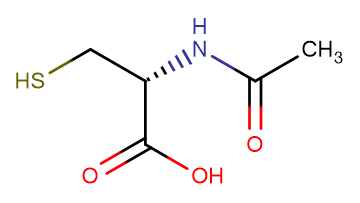
Acetylcysteine
CAS No. 616-91-1
Acetylcysteine( Acetylcysteine | NSC 111180 | NAC )
Catalog No. M15331 CAS No. 616-91-1
Acetylcysteine is a derivative of cysteine; an acetyl group that is attached to the nitrogen atom.
Purity : >98% (HPLC)
 COA
COA
 Datasheet
Datasheet
 HNMR
HNMR
 HPLC
HPLC
 MSDS
MSDS
 Handing Instructions
Handing Instructions
| Size | Price / USD | Stock | Quantity |
| 10MG | 53 | In Stock |


|
| 25MG | 96 | In Stock |


|
| 50MG | 170 | In Stock |


|
| 100MG | Get Quote | In Stock |


|
| 200MG | Get Quote | In Stock |


|
| 500MG | Get Quote | In Stock |


|
| 1G | Get Quote | In Stock |


|
Biological Information
-
Product NameAcetylcysteine
-
NoteResearch use only, not for human use.
-
Brief DescriptionAcetylcysteine is a derivative of cysteine; an acetyl group that is attached to the nitrogen atom.
-
DescriptionAcetylcysteine is a derivative of cysteine; an acetyl group that is attached to the nitrogen atom. This compound is sold as a dietary supplement commonly claiming antioxidant and liver protecting effects.Acetylcysteine (also known as N-acetylcysteine or N-acetyl-L-cysteine or NAC) is primarily used as a mucolytic agent and in the management of acetaminophen poisoning. It is a derivative of cysteine with an acetyl group attached to the amino group of cysteine. NAC is essentially a prodrug that is converted to cysteine (in the intestine by the enzyme aminoacylase 1) and absorbed in the intestine into the blood stream. Cysteine is a key constituent to glutathione and hence administration of acetylcysteine replenishes glutathione stores. Acetylcysteine can also be used as a general antioxidant which can help mitigate symptoms for a variety of diseases exacerbated by reactive oxygen species (ROS). For instance, acetylcysteine is commonly used in individuals with renal impairment to prevent the precipitation of acute renal failure. Acetylcysteine has been shown to have efficacy in treating mild to moderate traumatic brain injury including ischemic brain injury, particularly in reducing neuronal losses, and also reducing cognitive and neurological symptoms when administered promptly after injury. N-acetylcysteine is now widely used in the treatment of HIV, and it has reported efficacy in chronic obstructive pulmonary disease and contrast-induced nephropathy. Acetylcysteine is also being successfully used to treat a variety of neuropsychiatric and neurodegenerative disorders including cocaine, cannabis, and smoking addictions, Alzheimer’s and Parkinson’s diseases, autism, compulsive and grooming disorders, schizophrenia, depression, and bipolar disorder. Recent data also shows that N-acetylcysteine inhibits muscle fatigue and can be used to enhance performance in endurance events and in exercise and endurance training.
-
In Vitro——
-
In Vivo——
-
SynonymsAcetylcysteine | NSC 111180 | NAC
-
PathwayEndocrinology/Hormones
-
TargetATPase
-
RecptorACY1| GluR| NF-κB| NAPQI
-
Research AreaNeurological Disease
-
Indication——
Chemical Information
-
CAS Number616-91-1
-
Formula Weight163.19
-
Molecular FormulaC5H9NO3S
-
Purity>98% (HPLC)
-
SolubilityEthanol: 33 mg/mL (202.21 mM); Water: 33 mg/mL (202.21 mM); DMSO: 33 mg/mL (202.21 mM)
-
SMILESSC[C@@H](C(O)=O)NC(C)=O
-
Chemical NameCysteine, N-acetyl-, L-
Shipping & Storage Information
-
Storage(-20℃)
-
ShippingWith Ice Pack
-
Stability≥ 2 years
Reference
1.Alvirez-Freites EJ, et al. Antimicrob Agents ChemOthers, 2002, 46(4), 1022-1025.
molnova catalog



related products
-
BRITE338733
BRITE 338733 is a novel inhibitor of ATPase. BRITE 338733 inhibits the expression of RecA in bacteria with IC50 value of 4.7 μM for the bacterial infections treatment.
-
Reboxetine
Reboxetine is an antidepressant drug used in the treatment of clinical depression, panic disorder and ADD/ADHD.
-
Diazoxide
Diazoxide is a potassium channel activator, which causes local relaxation in smooth muscle by increasing membrane permeability to potassium ions.



 Cart
Cart
 sales@molnova.com
sales@molnova.com


